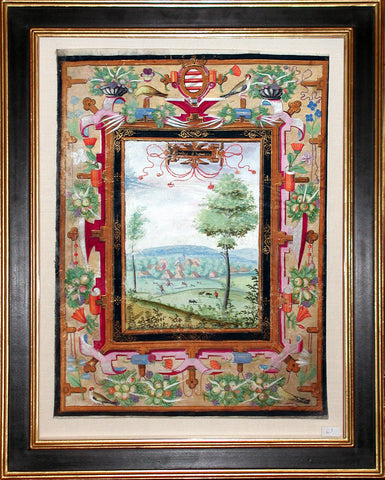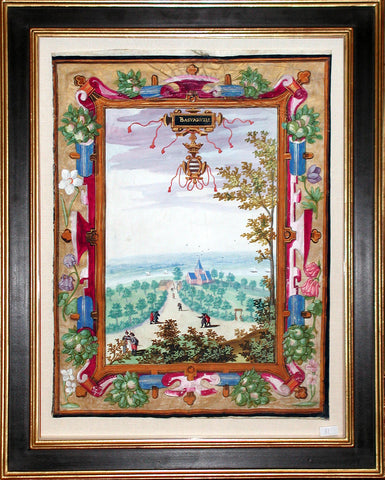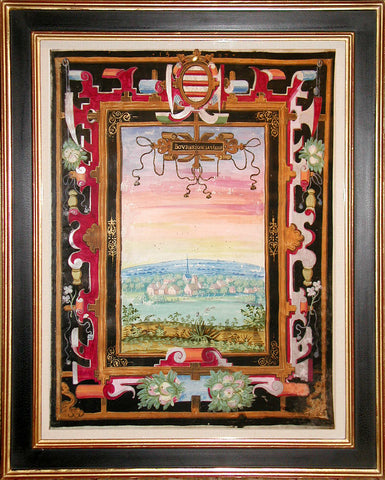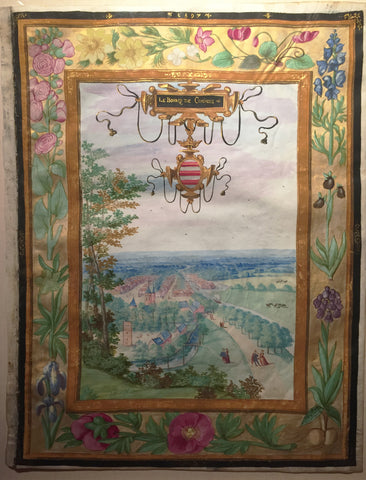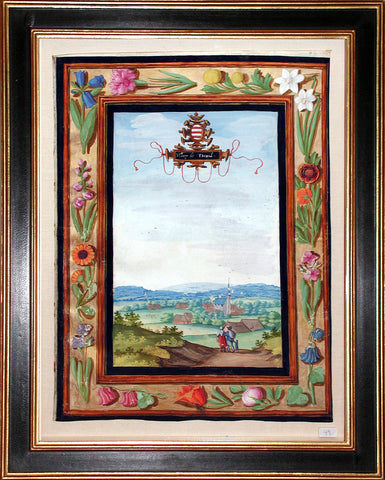
Adrien de Montigny (French, C1570-1615), Chaivieve
Chaivieve
Watercolor and gouache on vellum
1596 - 1598
Vellum size: 20 ½ x 15 ¼ in.
Frame size: 26 x 21 in.
SHOWING RENAISSANCE ESTATES AND NATURAL HISTORY SUBJECTS
BY ADRIEN DE MONTIGNY (c1570-1615)
ORIGINALLY FROM THE COLLECTION OF CHARLES DE CROŸ,
FOURTH DUKE OF AARSCHOT
Adrien de Montigny was a painter from Valenciennes in northern France. While few records remain, we do know that his magnum opus was the collection of vellums he created for the Duke de Aarschot Charles de Croÿ. Therefore, he was likely the Duke’s court painter.
Adrien de Montigny, whose name often appears at the head of the albums and in some of the cartouches on the individual folios. The Albums de Croÿ are his only known work, with the exception of a representation of the Chateau de Heverlee made on parchment, also for Charles de Croÿ. The evidence seems to indicate that he was the exclusive court artist to the Duke, and the work that was entrusted to him was indeed extensive. The artist was required to explore and sketch every region that the Duke wanted to memorialize in the albums, including each city, village, castle, abbey and convent. De Montigny made these expeditions primarily during the spring and summer seasons, spending the winter in his studio, where he worked his preliminary sketches into finished compositions on parchment. They are sumptuous, pristine watercolors of outstanding esthetic quality, clearly intended from their inception to be works of art above and beyond their documentary function. De Montigny frequently enlivened his compositions, based initially on surveys made by Pierre de Bersacques, with figures of local people engaged in daily activities: fishing, farming, or riding, and sometimes playing a musical instrument, creating a picture of overall social harmony in a manner that recalls Pieter Bruegel.
The mind of an inspired artist at work is perhaps most evident in the sumptuous borders, decorated with jewel-like curls in gold or silver, architectural elements, or flowers, fruits, birds, and animals. The borders are of different types, the simplest being black with gold or silver ornament, some having architectural details embellished by flowers and fruit, and some with a neutral background against which are placed birds, insects, flora and such, all depicted with striking naturalism. Many show examples of highly distinctive strapwork decoration, a hallmark of late European Mannerism. Strapwork was widely popular throughout the late 16th and early 17th centuries, a type of ornament generally employed for borders that was composed of bands with the appearance of having been cut from leather or sheet metal, then twisted and rolled into fantastic shapes. The origins of strapwork are to be found in Italian art at the beginning of the 16th century, and interlacing bandwork or strapwork appeared on bookbindings in Italy and Spain from the mid-15th century into the 16th. Early examples of bandwork used to articulate fields of ornament occur in Raphael’s decoration of the Vatican Loggia (1518-19). Closer to de Montigny’s center of activity, Rosso Fiorentino introduced a developed and highly individual form of strapwork in the stucco frieze of the Gallerie of François I at Fontainebleau. In Flanders, Cornelis Floris introduced strapwork into his decoration of the illuminated initial letters in the ledgers of the Guild of St Luke in Antwerp (1541) and developed the massive Fontainebleau strapwork into a yet more distinctive style of his own. At the same time he and his contemporary Cornelis Bos experimented with an altogether lighter, more elegant variety. Their printed designs (from c. 1550), together with those of Jacob Floris (1524-81) and Hans Vredeman de Vries, disseminated Flemish strapwork to every part of northern Europe and, to a lesser extent, to Italy and the Iberian peninsula. De Montigny’s masterful appropriation of this sort of design in the albums is highly inventive, for he combined the geometric forms of conventional strapwork with the organic beauty of animals, flowers, and fruits, leading to a distinctly personal and completely unparalleled form of decoration in these watercolors.
Duke Charles de Croÿ and the Collection of Albums assembled over four hundred years ago, the collection of watercolor albums commissioned by Duke Charles de Croÿ constitutes one of the most remarkable historical records of the towns and villages of the Low Countries of the 16th and 17th centuries, and a foremost artistic expression of the French LateRenaissance style. Each watercolor memorializes an estate or town that formed part of the dukedom, with the majority of these views surrounded by lavish borders comprised of combinations of natural history imagery, including cut tulips and other flowers, fruits and vegetables, and wildlife, including owls, peacocks, dogs, monkeys, and other animals. A vast compendium of unusually large watercolors, they are works of extraordinary importance for the architectural history, topography, and history of northern France and Belgium during a time of marked social upheaval and change. Esthetically, the albums are equally extraordinary as monuments in Northern Renaissance book illumination, unprecedented for the large size of the folios and the quality of the painting.
In the past several decades, scholars, most notably Jean-Marie Duvosquel of Brussels, have devoted a great deal of research to tracing the evolution of the albums and to reconstructing the personal history of their collector. Charles de Croy was a prominent member of one of the great noble families which, under the dukes of Burgundy and the kings of Spain, played a considerable role in the political and economic life of the Low Countries. Born at the Chateau de Beaumont on July 1, 1560, he was the son of Philippe, Third Duke of Aarschot, and of Jeanne, Dame of Comines and of Halluin. His father was quite active during the wars of religion between the Dutch Calvinist rebels and the Spanish Catholic overlords, a struggle that had as much to do with political as religious independence. In the midst of the conflict, on September 3, 1580, Charles de Croÿ married the widow of Lancelot de Berlaymont, Marie de Brimeu, an extremely wealthy Calvinist heiress and his elder by ten years. Marie exerted a strong influence on her young husband, leading him to renounce his Catholic faith and abandon the cause of the King of Spain, Phillip II. As Holy Roman Emperor, Phillip ruled all of the Netherlands and was then trying to maintain his authority in the face of the dramatic religious and political conflict that would soon see the northern provinces (present-day Holland) gain independence, while the southern provinces (present-day Belgium and northern France) remained subjugated to Spanish rule. In the late 16th-century Low Countries (as the Netherlandish provinces were collectively known), religion and politics were inseparable. One’s choice of Protestantism or Catholicism could signal either loyalty to the Spanish overlords, or desire to rebel from them and gain freedom. Thus Charles de Croÿ’s rapid conversion was hardly without political ramifications. Indeed, with his vast and increasing patrimony, his allegiance could potentially have had significant consequences for the fate of his native land.
Yet Charles de Croÿ, who until the death of his father in 1595 was usually known as the Prince of Chimay, was somewhat of an independent maverick both religiously and politically. Initially Catholic, then Protestant, he was ultimately not very supportive of either Philip II of Spain or the rebels led by the Prince of Orange (and after 1584 by his son Maurice of Nassau). The religious flip-flops become more understandable once it becomes clear that he, like his father, sought whatever was best for his own estates, which were considerable. Both men basically detested both the Spanish troops and the Calvinist radicals who eventually seized control of the States-General, the governing body. Indeed, the latter event surprised the elder Aarschot, who figured Orange and all the other rebels would return to Catholicism once the Spanish were chased out. Neither man ever really understood the religious dimension of the Dutch Revolt, nor how deeply rooted Calvinism had become among the burghers of some of the towns in Holland and Zeeland, the two most radical provinces and, incidentally, among the most geographically distant.
In light of such ambivalent loyalties, it is unsurprising that Charles de Croÿ’s foray into Calvinism proved to be shortlived. In 1585, a year after separating from his wife, he returned to the Catholic Church and began to take part in a number of military expeditions on behalf of the Spanish government, assuming a role of ever-expanding prominence in the political life of the Low Countries. His brief moment of disloyalty to the Spanish government and to Catholicism resulted in no change in his personal fortune, which was then growing considerably. After the death of his father in 1595, he found himself in possession of all Croÿ lands. Even prior to this his territorial holdings had been vast, for upon his marriage he had taken possession of the principality of Chimay, and after the death of his mother in 1581 he inherited the entire patrimony of the Comines-Halluin dynasty. To this was now added the entire duchy of Arschot, the principality of Chateau-Porcien, and the regions of Beaumont, Seninghem, Avesnes, Lillers, Quievrain, Esclaibes, Beveren, Fumay, and Revin. His rule over his domains was analogous to that of a prince over his states, as the administration of such vast holdings required that he form a council and chamber of counts to facilitate their effective management.
Despite his separation from Marie de Brimeu, Charles also retained control of her patrimonial lands until as late as 1599. Marie died in 1605, and eight months after her death Charles married his German cousin Dorothée de Croÿ, eldest daughter of the Duke of Havré. From that moment, he retired from public life to devote himself exclusively to the running of his lands and to building his art collection, including his celebrated collection of albums. He died in the Chateau de Beaumont on January 12, 1612. His widow survived him by 50 years and, without legitimate heirs, his property went to the family of his nephew, Alexandre d’Arenberg, upon her death.
The Albums de Croÿ
In 1595, Charles de Croÿ was not only at the height of his fortune after inheriting his father’s properties, but also an extremely informed and erudite collector, amassing paintings, manuscripts, and medals in his favorite residences at Beaumont and Heverlee. He kept scrupulous records of his collection as well as maintaining the family archive, annotating by hand each of the tens of thousands of files that his ancestors had accumulated over the course of centuries. More than any other factor, it was his high standards and discerning eye that led to and informed the genesis of his collection of albums.
The idea for the project developed rapidly. In 1590, Charles had a “table” of taxes and rent quotas drawn up relating to the lands of Comines and Halluin that he had inherited upon the death of his mother. At about the same time he had a similar table compiled for the principality of Chimay, legally under his regency since the time of his marriage to Marie de Brimeu. These “tables” were in the form of atlases, comprised of many watercolor maps and plans in the manner of a land register, along with a number of views of castles and villages. Unlike the albums whose production they inspired, however, these were primarily administrative documents, and the maps included were clearly the work of their surveyor, Pierre de Bersacques, rather than an artist. This project was realized in 1596-8, with Bersacques’s maps and notations eventually comprising two tomes that are still in the collection of the Croÿ estate: one covering the territories in Hainaut, the other the lands in Brabant, Flanders, Namurois, Artois and Picardy. The compilation of these large volumes gave Charles the idea to commission his court artist to re-draw the maps on parchment, a more luxurious medium than paper, and to supplement them with a view of each locality, painted in gouache in the manner of a painting. The purpose thus became not just administrative but consciously esthetic, the goal not merely efficient management but sumptuous glorification of his vast land holdings.
The views themselves are also delicately nuanced and highly distinctive, showing Montigny’s mastery of the difficult medium of watercolor. Distance is portrayed with skilled use of atmospheric perspective, the far hills fading towards blue tones, and the sky and fields are carefully modulated to evoke a particular season and time of day. The result of de Montigny’s amalgamation of direct observation and artistic license is an unprecedented and seamless mixture of the realistic and the fantastic, a vision of the countryside that is both bucolic and informative.
Delighted with the results, Charles expanded the project to include not only the lands in his patrimony but also those in which he exerted a significant influence. These included parts of the principality of Hainaut, where Charles was born, where he held the majority of his lands, and where he served as lieutenant, governor, captain general and grand bailiff. Hainaut was the subject of five albums, compiled and drafted from 1598-1602, supplemented by an album relating to Tournai and Tournaisis, completed in 1602. After his native province, Charles turned his attention to the birthplace of his mother. In 1603, he commissioned an album relating to the province of Lille, Douai, and Orchies, another region in which he held a number of important positions by virtue of his possession of Comines. Between 1604 and 1605 the album devoted to Namur was compiled, and in 1605-11 the final album was finished, dedicated to Artois, where the Duke had served as governor and captain general since 1597.
Charles de Croÿ divided this magnificent and sumptuous collection of 2,500 views, all painted on large parchment folios, into 23 volumes, which he housed in his library in the Tour de Sainte Barbe at the Chateau de Beaumont. There he spent many hours leafing through the volumes and verifying their exactitude, as witnessed by the existence of notations in his hand on a number of folios. At the time of his death, the volumes were inventoried and, the following year, were sent to Brussels and sold on August 19, 1614. Some volumes remained in the collection of the family, others were acquired by bibliophiles who, in turn, sold them to other book collectors, who sometimes modified the contents or “broke” them into individual views. Today, the original collection has been dispersed to a number of different countries, including Belgium, France, Germany, Austria, the Czech Republic, and the United States.
An examination of the images from the Album d’Authal reveals a striking diversity of representations: maps, plans, views, and heraldic designs alternate in the first two parts, while the third is more homogenous. The hybrid character of the album is not limited to the manner in which figurative elements are placed side by side with maps, for often these different forms of representations -- the cartographic and the pictorial -- are combined in one composition. A number of folios that are primarily maps, for example, include elements such as figures, houses and churches drawn in elevation. The descriptive, objective, and illustrational are intertwined in this album in a very distinctive manner. Some scholars have identified this sort of mixed representation as a transitional point towards the bird’s eye view, normally taken from an imaginary vantage high above a locality such that its geography, landmarks, and even sometimes the character of its inhabitants can be grasped in one glimpse. Other elements included by de Montigny are purely imaginary embellishments, such as the fictional hills he added to many views, receding gradually towards the horizon in the background, or incidental pastoral scenes of aristocratic men and women engaging in leisure activities.
In light of the heterogeneous nature of the folios in the album, the richly decorative borders assume the role of unifying the varying representations. Other factors, too, are generally constant throughout the album. Frequen ly, the pictorial representations of churches and homes are stereotyped rather than being particularized, while the color too has a symbolic rather than purely descriptive function: brown signifying fields, green for meadows, blue for rivers, streams, ponds, etc.
One particularly remarkable element of the folios in the album is their complete sense of tranquility, for the actual social situation at the time was far from harmonious. The majority of the Duc de Croÿ’s lands were hit quite hard by the ravages of religious conflict and war during the years 1596-8, as the bitter and bloody struggle between the Netherlands and Phillip II of Spain had reached a climax. With the northern provinces - present-day Holland - having fought for and won independence, the southern regions, including much of present-day Belgium and northern France, remained under Spanish control and absorbed much of the fallout of the bitter war. Compounded by the struggle between the Catholic and Protestant factions, the period was one marked by social, political and religious upheaval that intertwined to create one of the most intense periods of turmoil in the history of early-modern Western Europe. Against this historical background, Charles de Croÿ commissioned his court artist to paint these splendid views of his far-flung domain and to cloak them in the guise of perfect calm. In a moment when this very patrimony was threatened by the war with Spain, the duke chose to emphasize the abundance of the land in the borders with cornucopias of flora and fauna, and the serene life of the inhabitants going about their daily activities. These magnificent watercolors thus provided a sort of alluring escapism to their first owner, not unlike the distant but vivid pastoral evocation they offer to present-day viewers.
Charles de Croÿ preferred to memorialize and glorify his vast land holdings through idealization rather than unadulterated realism, and it was for this reason that he employed a painter rather than a cartographer to document them in his albums. He was extremely proud of his patrimonial lands and it is this that becomes evident through the striking coloring and general artistic refinement of their representation on paper. The historical and visual importance of this album is unquestionable, as is its place in the history of art. It is an exceptional source regarding the development of the countryside in the regions depicted: their architectural, agrarian and archeological history. The small scenes added by Adrien de Montigny give glimpses of the daily activities of four hundred years ago, and insights into the ways of life of the nobility as well as the more general population of the countryside, their popular traditions and customs.
These particular views originate from the Album d’Authal, one of the few that until recently remained in the collection of the Arenberg family. It covers three groups of Charles de Croÿ’s properties in four different regions: Brabant, Flanders, Artois, Picardy, and Namurois. The watercolors as a whole are a amalgam of the pictorial and the cartographic. De Montigny was not a surveyor but an artist by training, and he drew heavily on the original maps done by Pierre de Bersacques, supplementing and frequently altering them in conjunction with his own observations and imaginative touches. As a result of this unusual combination, there are few precedents for such a hybrid luxury production of equal scope and splendor as the albums. Books of Hours, such as the most famous, the Tres Riche Heurs done by the Limbourg brothers in the 15th century for Jean, Duc de Berry, sometimes include similar subject matter but tend to be much smaller in scale than the Albums de Croÿ, which are too large and elaborate to be categorized as books of miniatures.
Watercolors on vellum: many with paintings on recto and verso
Each approximately 20 ½ x 15 ¼ in.
1596 - 1598
Provenance: Charles de Croÿ; his nephew, Alexandre d’Arenberg; by descent to Ludmilla d’Arenberg; her son Engelbert de Croÿ; by descent to the present owner; purchased at Sotheby’s, Western Manuscripts and Miniatures, sale: L01323, London, 19 Jun 2001, paid $1.8 million for the entire collection.
Note: According to art historian JC Smith, nothing comparable has ever been created, in terms of extraordinary quality, size and decorative border. They are truly unsurpassed.
or by email at loricohen@aradergalleries.
We Also Recommend

